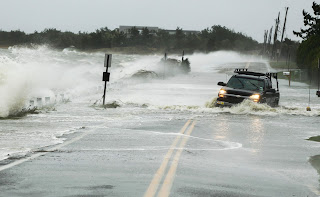Bethany
Mrs. Medenica
Science 7B
19 March 2013
Hurricanes
"A tropical
cyclone with winds of 74 miles (119 kilometers) per hour or greater that occurs
especially in the western Atlantic, that is usually accompanied by rain,
thunder, and lightning, and that sometimes moves into temperate latitudes"
-- Merriam Webster. In other words a hurricane is a storm with strong and
violent winds. Did you know that around five to nine hurricanes happen per year
(during hurricane season) and also hurricanes are not just a strong wind, they
also can cause tornadoes.
Hurricanes occur when hot and cold climates mix together. This
forms a cloud, shaped like a funnel. Hurricanes always form over the ocean.
Hurricanes form in the Pacific Ocean (most active on the Western side),
The Gulf of Mexico and in the Atlantic. For example: In the
Atlantic ocean during 2005 there was one of the most deadliest and most
destructive hurricanes, this hurricane was called, Hurricane Katrina. 1,833
people died because of flooding. The total property damage was an estimation of
$81 billion. This also shows what the results are of a hurricane. There
are many effects of a hurricane, one is storm surge. Storm surge is the rising
of the sea level. This is caused when strong winds push the water towards land.
Another effect is, heavy rainfall. Heavy rainfall is caused by the hurricane
because of when the wind is pushing the water toward land. The rainfall varies
from six to 12 inches. One more effect of hurricanes are that sometimes
tornadoes are produced by them. Some hurricanes produce several hurricanes
while some produce none. They are produced on the front, right quadrant of the
hurricane. A quadrant is, "Each of four quarters of a
circle" --dictionary.com.
You may wondering what people are doing to try to find out
if a hurricane is coming their way. The truth is that they have many ways. Have
you ever wondered when you were swimming in the ocean why there were colorful
buoys around you? Buoys provide information that is provided below the sea
including air and water temperature, wave height, and wind direction and speed.
Another way are satellites, the satellites provide snapshots of the earth. They
can also analyze cloud structures and read the temperature of the earths
surface. There are three different warnings. The first warning is called a,
Hurricane watch. A hurricane watch tells people that there is a possible
hurricane in the area. The next warning is called, Hurricane warning. A
hurricane warning is when an announcement is made that a hurricane is expected
to come. The last warning is, Extreme wind Warning. Extreme wind warning means
that the hurricane is traveling 115mph or greater and that you should
take immediate action.
There
are many benefits with many of the solutions to the problems. They are really
good because they help us contact the citizens of the town so that they can be
possibly evacuated, it could save many lives. When using buoys, this is a
really good way to raise awareness on future hurricanes. One it is
easy to see, and they are placed everywhere and also it doesn't take much
energy.
In conclusion as you can see hurricanes are very destructive and science
can help us by using buoys and satellites. Science is used when working with
buoys because you need to know where to put them. You use science to measure how
deep the water is in certain places and where there is the most current or
where hurricanes have happened before. Since these satellites
are research satellites, different then navigation satellites and
communication satellites. The satellites help the scientists by taking snapshots
of the world so that they can research them and see if the hurricane is coming
toward their city and how strong and fast the hurricane is going.
Hurricane Sandy
Works Cited
"How Do Hurricanes Form?" :: NASA's The Space
Place. N.p., n.d. Web. 19 Mar. 2013.
"Hurricane Basics: What Is a Hurricane?" Hurricane
Basics: What Is a Hurricane? N.p., n.d. Web. 19 Mar. 2013.
"Hurricane Katrina." Wikipedia. Wikimedia
Foundation, 19 Mar. 2013. Web. 19 Mar. 2013.
"HurricaneAbout Our Definitions: All Forms of a Word (noun,
Verb, Etc.) Are Now Displayed on One Page." Merriam-Webster.
Merriam-Webster, n.d. Web. 19 Mar. 2013.
"Hurricanes and Tornadoes." Hurricanes and
Tornadoes. N.p., n.d. Web. 19 Mar. 2013.
"Predicting Hurricanes: Times Have Changed." NOAA
200th Feature Stories: Predicting Hurricanes. N.p., n.d. Web. 19 Mar. 2013.
"United States." AccuWeather. N.p., n.d.
Web. 19 Mar. 2013.
"Where Do Hurricanes Occur Most Often?" WikiAnswers.
Answers, n.d. Web. 19 Mar. 2013.
"Why Do Hurricanes Occur?" WikiAnswers.
Answers, n.d. Web. 19 Mar. 2013.







No comments:
Post a Comment